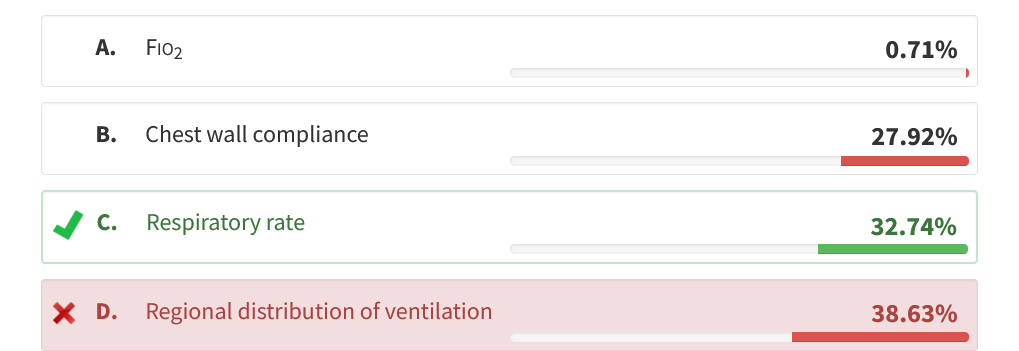mechanical power and VILI
- related: understanding of ventilators
- tags: #literature #pulmonology #icu
Ventilator-induced lung injury (VILI) has been linked to excessive stretch of alveolar tissue. This stretch is driven by stress (the applied transpulmonary pressure) and the resulting tissue strain (volume) both statically (at end inspiration and end expiration) and dynamically (during tidal volume delivery). These drivers can be expressed as work minus the integral of pressure over volume over a breath cycle. However, the actual energy expenditure is better expressed as work/time or power. Conceptually, power may thus be a better parameter with which to understand VILI mechanisms. Mathematically converting work to power simply involves incorporating respiratory frequency (breath cycles/min) to conventional stress and strain measurements of each breath (choice C is correct; choice A is incorrect). The full equation derived from the equation of motion is:
Power (J/min) = 0.098 × RR × (Vt2 × (1/2 × E + RR × (1 + I:E)/(60 × I:E) × Raw) + Vt x PEEP,
where RR = respiratory rate, Vt = tidal volume, E = system elastance, I:E = ratio of inspiratory to expiratory time, and Raw = airway resistance.
Chest wall compliance is a reflection of the relationship between applied pressure and volume change determined by chest wall mechanics—it does not reflect power (choice B is incorrect). The regional distribution of ventilation impacts the distribution of power within the respiratory system (choice D is incorrect). Ventilation (and power) distribution is driven by regional stress and mechanical properties, and regional injury reflects the ability of different regions to absorb energy and change volume. Our understanding of VILI is constantly evolving.
Factors associated with VILI development other than simple static and dynamic stretch likely include regional inspiratory/expiratory flow properties, regional acceleration forces, regional vascular pressures, and stress amplifiers at interfaces of regions with different mechanical properties. Mechanical power combines some of these features, and, not surprisingly, high values in observational studies have been associated with higher mortality. Clearly, limiting excessive tidal and maximal stretch is an important clinical goal today that continues to be built upon.123456
The concept of mechanical power as an important determinant of ventilator-induced lung injury (VILI) has been proposed by several groups in recent years. Mechanical power incorporates established VILI determinants such as static and dynamic stress and strain and adds to them the effects of which of the following?

Links to this note
Footnotes
-
Asar S, Acicbe Ö, Çukurova Z, et al. Bedside dynamic calculation of mechanical power: a validation study. J Crit Care. 2020;56:167-170. PubMed ↩
-
Cressoni M, Gotti M, Chiurazzi C, et al. Mechanical power and development of ventilator-induced lung injury. Anesthesiology. 2016;124(5):1100-1108. ↩
-
Marini JJ, Gattinoni L. Energetics and the root cause for ventilator-induced lung injury. Anesthesiology. 2018;128(6):1062-1064. ↩
-
Marini JJ, Rocco PRM, Gattinoni L. Static and dynamic contributors to ventilator-induced lung injury in clinical practice. Pressure, energy, and power. Am J Respir Crit Care Med. 2020;201(7):767-774. ↩
-
Serpa Neto A, Deliberato RO, Johnson AEW, et al. Mechanical power of ventilation is associated with mortality in critically ill patients: an analysis of patients in two observational cohorts. Intensive Care Med. 2018;44(11):1914-1922. ↩